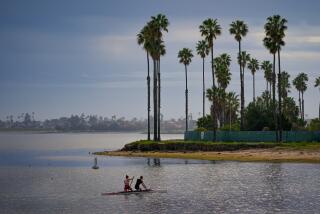Carlsbad’s Lagoon Plan Worries EPA : Environment: It isn’t “comfortable” with plans to let nature take its course after Batiquitos Lagoon is dredged.
- Share via
The Environmental Protection Agency has expressed concerns that plans to promote growth of new plant life at Carlsbad’s Batiquitos Lagoon are inadequate.
“We’re not comfortable that this area will revegetate appropriately,” said Steven John, a wetlands biologist for the EPA.
In addition, the EPA says money budgeted for monitoring the $30-million lagoon restoration and enhancement project might not be enough.
The EPA is unhappy with Carlsbad’s plans to let the lagoon grow plants without intervention, instead of actively colonizing the area with plants.
“The plan said we’re going to go in and dredge the area, provide what we think are appropriate (water) elevations and these places will naturally vegetate,” said Steven John, a wetlands biologist for the EPA. “Something needs to be done to provide a faster revegetation and habitat recreation.”
He suggested that cord grass and pickleweed be actively introduced as part of the replanting.
The EPA’s comments, which are not binding, came last Friday in reaction to an environmental impact statement submitted by the city in applying for a permit from the Corps of Engineers for the restoration project.
The project, which the city plans to begin next year, would dredge sediment from the mouth of the lagoon and return the lagoon to its original state where water levels ebbed and flowed with the tides. The project is being financed by the Port of Los Angeles because the port, which is expanding, is required by the state to make environmental improvements to an undeveloped coastal area and has chosen Batiquitos Lagoon.
Sediment and sand built up at the mouth of Batiquitos Lagoon since the early 1980s has shut off water access to the ocean, leaving behind a floor of cobblestones with little vegetation.
The quality of the lagoon’s water varies with the seasons, becoming almost fresh water in the winter after the rainy season and salty in the summer, when much of the water evaporates and leaves a stench.
Gary Wayne, assistant planning director for Carlsbad, said that the EPA’s concerns “are not a problem” to the application.
Wayne said that cord grass, which has not grown near the lagoon for some time, might not be indigenous anyway and that the area’s present vegetation includes pickleweed.
“You’ll see an extension of the pickleweed, and the whole salt marsh succession there, and we may even get eel grass,” Wayne said.
Wayne said that existing salt marshes will be replanted to barren areas of the lagoon and that it isn’t necessary to colonize new vegetation.
The EPA also questioned the amount of money set aside to monitor and maintain the project.
“They have to monitor bird use and the types of fish that recolonize the area . . . . These are extensive biological surveys that need to be done,” John said.
But Wayne said that the $200,000 a year set aside by the Port of Los Angeles for monitoring and maintaining the lagoon is more than enough and that the California Department of Fish and Game, which will eventually be responsible for managing the lagoon, was satisfied with that amount.
The permit from the Corps of Engineers is the first of two major permits necessary for the project to proceed, the other being from the California Coastal Commission, Wayne said.
More to Read
Sign up for Essential California
The most important California stories and recommendations in your inbox every morning.
You may occasionally receive promotional content from the Los Angeles Times.













